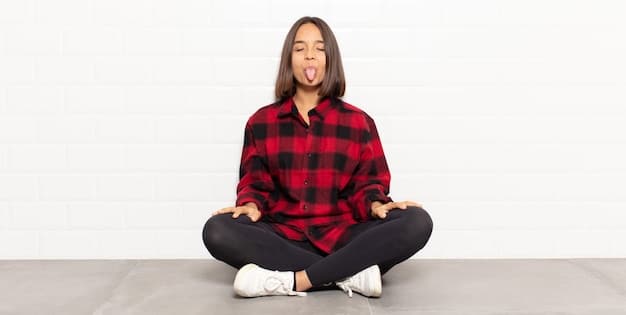Reduce Anxiety: 30-Day Mindful Breathing Guide

Reduce Anxiety by 10% in 30 Days: A Beginner’s Guide to Mindful Breathing Exercises provides a structured approach to incorporating mindful breathing techniques into your daily life, offering a practical pathway to lowered anxiety levels and improved well-being over a month.
Feeling overwhelmed by anxiety? This beginner’s guide, “Reduce Anxiety by 10% in 30 Days: A Beginner’s Guide to Mindful Breathing Exercises,” offers simple yet powerful mindful breathing exercises you can easily integrate into your routine to start feeling calmer and more centered within just a month.
Understanding Anxiety and the Power of Breath
Anxiety is a common emotion, but when it becomes persistent and overwhelming, it can significantly impact your daily life. While professional help is often necessary for severe anxiety, simple and accessible techniques like mindful breathing exercises can provide immediate relief and long-term benefits in managing everyday stress and unease.
Mindful breathing is more than just taking deep breaths; it involves focusing your attention on the sensation of your breath, allowing you to anchor yourself in the present moment and detach from anxious thoughts. By consciously controlling your breathing, you can activate your parasympathetic nervous system, which promotes relaxation and reduces physical symptoms of anxiety such as rapid heart rate and muscle tension.
The Science Behind Mindful Breathing
Research has shown that mindful breathing exercises can effectively reduce anxiety and improve overall well-being. Deep, slow breathing stimulates the vagus nerve, a key component of the parasympathetic nervous system. This stimulation helps to counterbalance the “fight or flight” response triggered by anxiety, leading to a calmer state of mind and body.
Benefits of Mindful Breathing for Anxiety
Integrating mindful breathing into your daily routine offers a multitude of advantages. Beyond immediate anxiety relief, regular practice can enhance your overall emotional resilience and improve your ability to cope with stressful situations. It’s a readily available, cost-free tool that empowers you to take control of your mental and emotional state.
- Reduces physical symptoms of anxiety (e.g., rapid heart rate, muscle tension)
- Promotes relaxation and a sense of calm
- Improves focus and concentration
- Enhances emotional regulation
In conclusion, understanding the connection between anxiety and the power of breath is the first step towards managing your anxiety effectively. Mindful breathing provides a simple yet potent tool to calm your mind and body, paving the way for a more balanced and peaceful life.
Getting Started: Basic Mindful Breathing Techniques
Embarking on your mindful breathing journey doesn’t require any special equipment or prior experience. These basic techniques are designed to be easily accessible and adaptable to your individual needs and preferences. Experiment with different methods to discover what resonates best with you.
Creating a dedicated space and time for your practice can enhance its effectiveness. Find a quiet, comfortable environment where you can minimize distractions. Whether it’s a cozy corner in your home or a peaceful spot outdoors, choose a setting that promotes relaxation and allows you to fully focus on your breath.
Diaphragmatic Breathing (Belly Breathing)
Diaphragmatic breathing, also known as belly breathing, involves engaging your diaphragm to facilitate deeper, fuller breaths. This technique encourages relaxation by stimulating the vagus nerve and promoting a sense of calm.
Box Breathing (Square Breathing)
Box breathing is a simple yet effective technique commonly used by Navy SEALs to manage stress and improve focus. It involves inhaling, holding, exhaling, and holding again – each for the same duration – creating a sense of balance and control.

- Find a comfortable position: You can sit, lie down, or stand.
- Focus on your breath: Pay attention to the sensation of the air entering and leaving your body.
- Count your breaths: This helps to maintain focus and prevent your mind from wandering.
In brief, starting with basic mindful breathing techniques sets the foundation for a more relaxed and focused state of being. Experimenting with diaphragmatic and box breathing can help you find the techniques that work best for managing your anxiety.
Creating a 30-Day Mindful Breathing Plan
Consistency is key when integrating mindful breathing into your daily routine for anxiety reduction. A structured 30-day plan can help you establish a habit and track your progress effectively. Start by setting realistic goals and gradually increasing the duration and frequency of your practice.
Begin with a few minutes of mindful breathing each day and gradually increase the duration as you become more comfortable. Even just five minutes of focused breathing can make a significant difference in your anxiety levels. Listen to your body and adjust the plan based on your individual needs and responses.
Week 1: Establishing the Habit
Focus on consistency rather than perfection. Aim for at least five minutes of mindful breathing each day, even if your mind wanders frequently.
Week 2: Exploring Different Techniques
Introduce new breathing exercises to find what works best for you. Try alternate nostril breathing or body scan meditation alongside your basic practices.

- Set a specific time each day: This helps to create a routine and ensures you don’t skip your practice.
- Use reminders: Set alarms on your phone or leave notes in visible places to remind you to breathe mindfully.
- Track your progress: Keep a journal to note how you feel before and after your breathing exercises.
In short, crafting a 30-day mindful breathing plan helps turn the practice into a habit. By focusing on consistency and gradually exploring different techniques, you can effectively manage your anxiety levels with regular practice.
Tracking Your Progress and Noticing Changes
Monitoring your progress is essential for staying motivated and understanding the impact of your mindful breathing practice. Regular tracking can reveal subtle yet significant changes in your anxiety levels and overall well-being. Keeping a journal or using a tracking app can help you document your experiences and identify patterns.
Pay attention to both your physical and emotional responses to the exercises. Note any changes in your heart rate, muscle tension, breathing patterns, and emotional state. Also, reflect on how you handle stressful situations and notice if you’re responding with greater calm and composure. This awareness can be incredibly empowering.
Using a Journal for Tracking
A journal provides a space for you to record your daily experiences with mindful breathing. Note the date, time, type of exercise, and any observations you have regarding your physical and emotional state before and after the practice.
Recognizing Subtle Improvements
Improvements might not always be dramatic, but they are often noticeable over time. You might find it easier to fall asleep, experience fewer panic attacks, or react with greater patience to challenging situations. Acknowledge these small victories and celebrate your progress.
In conclusion, consistently tracking your progress and noticing subtle changes is crucial to understanding the benefits of mindful breathing. Using a journal and recognizing even small improvements can help motivate you to stick with the practice and manage your anxiety effectively.
Overcoming Challenges and Staying Motivated
Maintaining consistency in your mindful breathing practice can be challenging, especially when faced with busy schedules or periods of increased stress. It’s important to anticipate potential obstacles and develop strategies to overcome them. Remember that everyone experiences setbacks, and the key is to approach them with self-compassion and renewed commitment.
One of the biggest challenges is a wandering mind. It’s natural for your thoughts to drift during meditation, and the goal is not to eliminate thoughts altogether but to gently redirect your attention back to your breath each time your mind wanders. Be patient with yourself and avoid self-criticism.
Dealing with a Wandering Mind
When you notice your mind wandering, gently acknowledge the thought without judgment and steer your focus back to your breath. Imagine your thoughts as clouds passing by in the sky – observe them without getting carried away.
Finding Time in a Busy Schedule
Even on the busiest days, you can find small pockets of time for mindful breathing. Incorporate short breathing breaks during your commute, at your desk, or before meals. A few minutes of focused breathing is better than none at all.
- Set realistic expectations: Don’t aim for perfection; focus on consistency.
- Join a community: Find support and encouragement from others who practice mindful breathing.
- Reward yourself: Celebrate your milestones to stay motivated.
In summary, it’s important to recognize that overcoming challenges is a natural part of any mindful breathing practice. By dealing with a wandering mind, finding time in a busy schedule, and staying connected with others, you can maintain consistency and experience the long-term benefits.
Advanced Techniques for Enhanced Anxiety Relief
As you become more comfortable with the basic mindful breathing techniques, you can explore advanced practices to deepen your experience and enhance anxiety relief. These techniques often involve greater focus, visualization, or integration with other mindfulness practices. Remember to approach these advancements with patience and self-compassion, and listen to your body’s cues.
Alternate nostril breathing, also known as Nadi Shodhana Pranayama, is a powerful technique that balances the left and right hemispheres of the brain, promoting a sense of calm and equilibrium. This practice involves alternately closing one nostril while breathing through the other, creating a harmonious flow of energy throughout the body.
Alternate Nostril Breathing (Nadi Shodhana)
This technique balances the nervous system and promotes relaxation. It involves breathing through one nostril while holding the other closed, alternating sides with each breath.
Body Scan Meditation
Body scan meditation involves bringing awareness to different parts of your body, noticing sensations without judgment. This practice helps to release tension and increase body awareness.
In essence, as you progress in your mindful breathing journey, incorporating advanced techniques can significantly enhance your anxiety relief. Both alternate nostril breathing and body scan meditation can contribute to a deeper state of relaxation and mindfulness.
| Key Point | Brief Description |
|---|---|
| 🧘 Basic Breathing | Diaphragmatic and box breathing techniques to start calming anxiety. |
| 🗓️ 30-Day Plan | Consistency is key; gradually increase practice time each week. |
| ✍️ Track Progress | Journaling helps monitor changes and maintain motivation. |
| ⬆️ Advanced Techniques | Explore alternate nostril breathing and body scan meditation. |
Frequently Asked Questions (FAQ)
▼
Many people experience a noticeable reduction in anxiety within just a few days of consistent practice. The key is to practice regularly and be patient with yourself.
▼
It’s completely normal for the mind to wander. Gently redirect your attention back to your breath each time you notice your thoughts drifting. There’s no need to be critical.
▼
Mindful breathing can be a helpful complementary practice, but it should not replace medication prescribed by a healthcare professional. Consult your doctor before making any changes to your treatment plan.
▼
Start with just 5-10 minutes per day and gradually increase the duration as you become more comfortable. Even short sessions can provide significant benefits.
▼
Mindful breathing is generally safe, but if you have underlying health conditions or experience discomfort, consult your doctor before starting. Listen to your body and adjust as needed.
Conclusion
Incorporating mindful breathing exercises into your daily life offers a powerful and accessible tool to reduce anxiety and enhance overall well-being. By following this beginner’s guide and committing to a 30-day plan, you can experience tangible improvements in your mental and emotional state, moving towards a calmer, more centered you.





